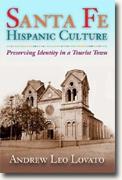Santa Fe Hispanic Culture
Andrew Leo Lovato
book reviews:
· general fiction
· chick lit/romance
· sci-fi/fantasy
· graphic novels
· nonfiction
· audio books
· author interviews
· children's books @
curledupkids.com
· DVD reviews @
curledupdvd.com
newsletter
win books
buy online
links
home
for authors
& publishers
for reviewers

 |
Santa Fe Hispanic Culture: Preserving Identity in a Tourist Town Andrew Leo Lovato University of New Mexico Press Paperback 154 pages September 2006 |
|
Most people who know or have been to Santa Fe, New Mexico think of that city as an Hispanic town - not surprising, since the city’s business and government seek to project that image to draw tourists. In that, Santa Fe has succeeded very well.
Lovato did discover at least two common traits among Hispanics: language and religion. Most speak Spanish, and most are Roman Catholics. A majority also consider family to be an important aspect of their lives. One way Hispanics celebrate their heritage in Santa Fe is with the annual festival called the Fiesta commemorating the return of the Spanish colonists to Santa Fe after having been driven out by the Indians of the Pueblos in 1692. The Fiesta combines different aspects of the Santa Fe Hispanic community; the Catholic Church is very much involved by celebrating special Masses. The Anglo community of Santa Fe has contributed additions to encourage more participants in the fiesta. A fiesta queen is chosen along with a man who will represent the leader of the Spanish re-conquest of Santa Fe, Don Deigo de Vargas, who is called “the de Vargas.” Lovato interviewed the queen and the de Vargas of the 1999 Fiesta. Because it celebrates a Spanish victory over them, this Fiesta has not been popular with some Native Americans. Lovato discusses this and other opposing views on this event. Lovato examines Hispanic cultural aspects of Santa Fe like its art, its architecture, statistics about the Hispanic population, and other issues of research importance. Most buildings in Santa Fe are of the adobe architectural style. There are a few exceptions, which Lovato discusses, even displaying on the book’s cover the St. Francis Cathedral, which is a Romanesque-style rather than adobe church. Black-and-white photos of some of his interviewees, of buildings, and of other Santa Fe scenes enrich the text. Santa Fe has become known for a place where you can find many kinds of art work, most with a Southwest flavor - which can mean Hispanic or Native American. With the art scene and Santa Fe’s tourism appeal, the city has become a magnet for visitors. The city is considered one of the major tourism sites of the world. An aspect of Catholicism in Santa Fe is the devotion to Our Lady of La Conquistadora (Blessed Virgin Mary, the mother of Jesus), also called more simply “La Conquistadora.” The center of this devotion is the statue of the Blessed Virgin Mary that Don Diego de Vargas and his army brought with them when they re-conquered Santa Fe in 1693. The statue (Lovato includes photos of it) is carried in processions during the Fiesta. Andrew Leo Lovato here provides an interesting examination of Santa Fe’s Hispanic identity. His book is recommended for those interested in Santa Fe, in Hispanic culture, and in social science research. Lovato is assistant professor of interdisciplinary studies and director of international programs at the College of Santa Fe. Originally published on Curled Up With A Good Book at www.curledup.com. © Br. Benet Exton, O.S.B., 2007 |
|
|
|
 Click here to learn more about this month's sponsor! |
|
| fiction · sf/f · comic books · nonfiction · audio newsletter · free book contest · buy books online review index · links · · authors & publishers reviewers |
|
| site by ELBO Computing Resources, Inc. | |
 Andrew Leo Lovato examines Santa Fe’s Hispanic culture by looking at the city’s history, how its people perceive themselves, this culture’s impact upon it, and how they celebrate being Hispanic. Lovato conducted personal interviews with several people who live in Santa Fe and ran surveys to glean more information as well as looking at other research on the topic. When he asked what Hispanics would most like to be identified as, the term “Hispanic” gained the most votes in his survey; “Latino”, “Chicano” and other terms were other choices. He discusses how the term “Hispanic” is used in a general way when the people to which it refers are actually of different nationalities; with different traditions, accents, and customs. They more accurately prefer to be known as Mexicans, Hondurans, Chileans, and their other nationalities rather than being lumped into one general category.
Andrew Leo Lovato examines Santa Fe’s Hispanic culture by looking at the city’s history, how its people perceive themselves, this culture’s impact upon it, and how they celebrate being Hispanic. Lovato conducted personal interviews with several people who live in Santa Fe and ran surveys to glean more information as well as looking at other research on the topic. When he asked what Hispanics would most like to be identified as, the term “Hispanic” gained the most votes in his survey; “Latino”, “Chicano” and other terms were other choices. He discusses how the term “Hispanic” is used in a general way when the people to which it refers are actually of different nationalities; with different traditions, accents, and customs. They more accurately prefer to be known as Mexicans, Hondurans, Chileans, and their other nationalities rather than being lumped into one general category.